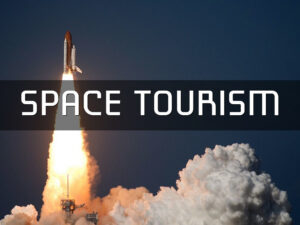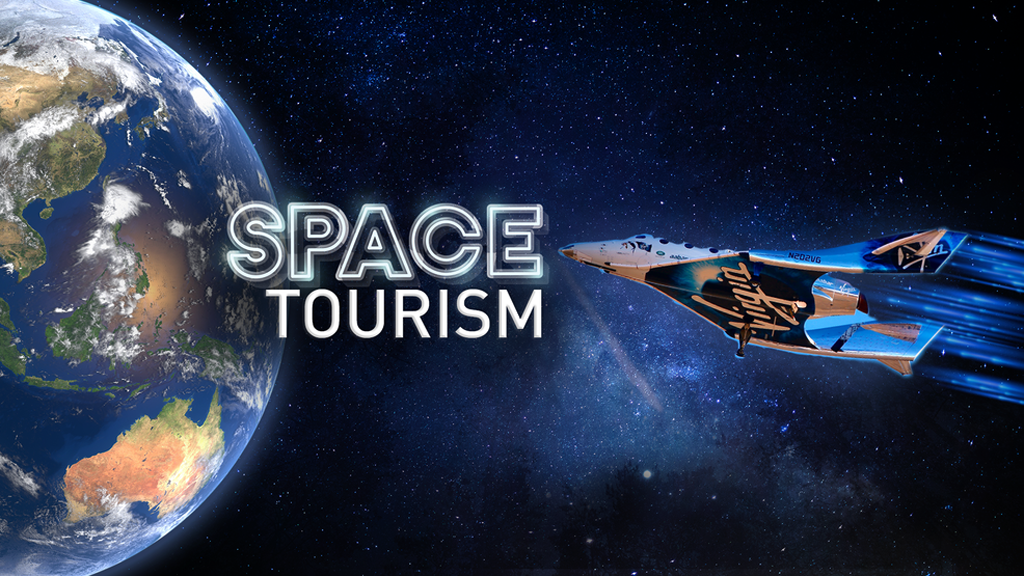The term “space tourism” describes the business practice of transferring people personally into space for enjoyment, exploration, or other non-scientific objectives. Science fiction is a vision of space tourism. And now it has become a reality due to technological improvements and cost savings. The extensive review will cover the background, present situation, major individuals, difficulties, and potential future developments of space tourism.
Emergence of Space Tourism:.
The development of space tourism signifies an important transition from government-driven space exploration to the role of private enterprises in allowing non-professional astronauts access to space. The development of this field is prompted by the public’s rising curiosity in space flight, prominent players’ entrepreneurial ambition, and technological developments.

⦁ History:
Science fiction writers such as Jules Verne and H.G. Wells wrote early representations of space travel. The main idea of space tourism originated from science fiction. The history of space tourism was born when people first imagined going to space for entertainment. The idea became more realistic in the 1990s, and a group came together to talk about it. Then, a competition encouraged teams to build tiny spacecraft that could travel to the edge of space in the early 2000s. It was proven that regular people could travel to space after one team won.
Afterwards, companies like Virgin Galactic and SpaceX started creating spacecraft offered to tourists. SpaceX has been sending people to the space station such as Jeff Bezos and other individuals who have recently taken off in rockets. It seems that space travel is getting more and more commonplace, and that number will probably increase in the future.
⦁ Pioneering Moments:
In the early 2000s, the journey of American businessman Dennis Tito became the first private individual to pay for a trip to space. After that, it is considered the real beginning of space tourism. Tito paid $20 million for a Russian Soyuz spacecraft to send him to the International Space Station (ISS) in 2001. His eight-day stay on the International Space Station (ISS) was an important achievement that helped establish the economic potential of private space travel.
After Tito’s journey with the Russian space agency, other rich people also went into space. Entrepreneurs Mark Shuttleworth of South Africa (2002), Gregory Olsen of the United States (2005), and Anousheh Ansari of Iran (2006) were also among the first space tourists after Tito. These flights proved that private space travel was possible, but they were only available to those with enormous price tags.
When will Space tourism be started?

Space tourism has already started due to a number of successful commercial space missions launched by organizations like Virgin Galactic, Blue Origin, and SpaceX. But the widespread accessibility of space tourism is dependent on several factors that are as follows:
⦁ Space travel will become more affordable and accessible to a wider range of people as reusable rockets and spacecraft improve both performance and low prices.
⦁ Space tourism will become much more accessible with regular and frequent spaceflights.
⦁ It is believed that increased investment and industrial development would result from the public’s growing interest in space flight.
Types of Space Tourism:
There are three types of space tourism that are as follows;
⦁ Orbital tourism
⦁ Suborbital tourism
⦁ Lunar tourism
⦁ Sub-orbital tourism:
A quick takeoff up and down to the edge of space is comparable to suborbital travelling. People can see Earth from an extensive distance and experience temporary nothingness. Space companies like Virgin Galactic and Blue Origin are developing suborbital travel. Virgin Galactic started commercial operations with well-known passengers like Richard Branson. On the other hand, Blue Origin has also sent out multiple crewed trips, including paying clients.
⦁ Orbital tourism:
This is a long trip that takes you through multiple Earth orbits. In this tour, tourists can spend days or even weeks in space and also enjoy longer stretches of weightlessness and amazing views. This type of tourism is still in the planning stages and has not yet occurred.
⦁ Lunar Tourism
There have been talks about companies offering tours of the moon to tourists. It is still in the future even though this trip would be quite costly and elegant.
Important role of companies in Space Tourism:
There are a number of leading companies that contribute with unique strategies and objectives in space tourism:
⦁ Space X:
Space Exploration Technologies Corporation (Space X) is a business project established by Tesla’s founder Elon Musk. Some think Musk’s lack of personal space travel sets him behind Bezos and Branson regarding space exploration. Space X also emphasized the longer orbital missions in space. Space X conducted the first orbital voyage from the Kennedy Space Center completely operated by tourists on September 15, 2021.
SpaceX wants to lower the cost of space travel and eventually make it possible for people to explore Mars. NASA astronauts have previously been sent to the International Space Station (ISS) by SpaceX’s Crew Dragon spaceship. The business also intends to provide commercial flights, such as a circumlunar journey for paying clients.
⦁ Blue Origin:
The second largest company that is interested in space tourism is Blue Origin. It was founded by Jeff Bezos who is the CEO of Amazon. Blue Origin’s New Shepherd Rocket sent Bezos and three other passengers into orbit on July 20, 2021. This journey was just nine days after the Virgin Galactic travel. Blue Origin is focused on creating reusable rocket technology to lower the cost and increase accessibility to space travel.
The website emphasizes a brighter future for our kids and the potential for millions of people to visit space. It is similar to Virgin Galactic’s approach. It is essential to discover new sources of energy and materials outside of Earth as highlighted in Blue Origin. On the other hand, they also put a little more emphasis on protecting the planet.
⦁ Virgin Galactic
Virgin Galactic was established in 2004 and is directed by Richard Branson. After more than a decade, Branson became the first space tourist when he introduced a crew consisting of two pilots and three other passengers into orbit on July 11, 2021. The suborbital flight extended ninety minutes at a height of eighty-five km.
Branson offers a simple message expressing his hope on the website, that the prospect of space flight will capture and inspire millions of children worldwide. This design attempts to enable suborbital flights in order to give tourists a few minutes of gravity and incredible views of the Earth.

Advantages of Space Tourism:
There are several advantages to space travel for both people and society as a whole. The following are some of the main benefits.
⦁ Space exploration has the potential to spark people’s interest in STEM (Science, Technology, Engineering, and Mathematics).
⦁ People’s understanding of the sensitivity of our planet can be enhanced by seeing it from orbit, which may increase their support for environmental conservation efforts.
⦁ The growth of Space tourism demands technological advancements in spaceship design, propulsion, and life support technology.
⦁ The space tourism sector has the ability to boost employment and economic growth across a range of industries based on launch locations and training centers.
⦁ The cost of going into space may decrease as the space tourism industry expands and flourishes. Innovations and ways to reduce expenses developed for space tourism may eventually allow governments, academic institutions and commercial groups.
⦁ Government and private sector collaboration can be encouraged by space tourism. It also leads to more innovative and successful space projects. This collaborative structure has the potential to speed up technological and space exploration developments.
⦁ The variety of activities available in space is growing as space travel gains popularity. Long-term space travel requires a deeper understanding of living and working in space.
Future of Space Tourism:
There are a number of fascinating advancements in space travel that augur well for the industry’s future.
⦁ Cost:
The cost of space travel is predicted to decrease with future technological developments, especially in the area of reusable rockets. A larger portion of the public will be able to enjoy space tourism due to this price reduction.
⦁ Hotels in space:
There are the following companies such as Orbital Assembly Corporation and Axiom Space intend to construct space hotels that will offer longer stays in orbit. These facilities will provide unique experiences such as spacewalks, chances for scientific study, and breathtaking views of Earth.
⦁ Experience:
Space travellers will be able to enjoy increasingly varied and engaging experiences as technology develops. Space sports, virtual reality, and other activities are going to make space tourism more appealing.
Societal and Cultural Impact on Space Tourism:
Space travel has the power to significantly change culture and society. Younger people such as the generation of engineers, explorers, and scientists can be motivated by it. The “Overview Effect,” or the viewpoint of watching Earth from space, help people to understand how important it is to preserve our planet. Furthermore, space tourism could lead to technical developments that have greater effects on Earth. It can make better transportation systems and also advances in sustainable energy.



1 Comment
Pingback: Camilla Araujo – Age, Bio, Height, Weight,Relationship, Net Worth